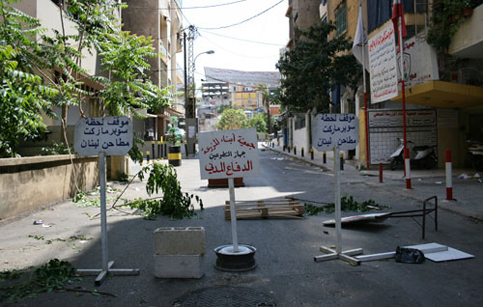Photo Essay: Beirut Streets. May 2008
- Photo essay from Carole Kerbage.

Beirut May 10th 2008: Barbour district Beirut witnessed harsh armed battles.
As Lebanon’s political crisis moves to a temporary negotiated solution, tensions remain high after intense street level clashes in recent weeks between pro-government forces and the Hezbollah-backed opposition. Street barricades struck across Lebanon’s capital city have now been removed, as Lebanese political leaders return to Beirut after arriving at an agreement in Doha, Qatar.
This photo essay documents recent events in Beirut’s, featuring images captured at street level within recent weeks. Lebanon’s current political struggle extends back to an intense national political history, in a nation still recovering from a 2006 Israeli bombardment that left over 1000 Lebanese civilians dead and major elements to the countries national infrastructure destroyed. Lebanese photographer Carole Kerbage has documented Beirut’s streets in the past week and now features photographs from Beirut on Tadamon!

Beirut May 7th 2008: Lebanon’s General Labor Confederation’s national strike strike, demanding higher wages, turns into violent political conflicts between the Hezbollah-lead opposition and supporters of the western-backed government.

Beirut May 7th 2008: Beirut is brought to a stand-still as a national strike has quickly turned into a national political crisis leading to days of fierce political clashes between armed movements on Beirut’s streets, marking the largest internal political crisis in Lebanon since the civil-war between 1975 and 1990.

Beirut May 7th 2008: Multiple major roads and highways are blocked by the Hezbollah-lead opposition as part of swift reaction to a series of government initiated decisions targeting the Lebanese resistance, specifically a decree aiming to removed Hezbollah’s national independent telecommunications system.

Beirut May 12th 2008: Bechara Khoury area in Beirut with a Lebanese military tank stationed on the street, Lebanon’s military didn’t take a position on either side within Lebanon’s recent civil-conflict presenting a veneer of neutrality as a national institution not embroiled in sectarianism.

Beirut May 12th 2008: Lebanese military stationed outside of Abdul Nasser Mosque in Mazraa, Beirut. Lebanon’s national army was stationed throughout the capital in the days of fighting in May 2008.

Beirut May 2008: A building in Beirut covered in posters for the Amal Movement, a widespread predominately Shi’ite armed political party in Lebanon operating within the Hezbollah-lead opposition. Political posters and graffiti are widely common throughout Lebanon’s capital.
Carole Kerbage is a political science student and activist in Lebanese civil society, trying to create political and social change. Currently, she is a freelancer journalist, publishing articles in different Lebanese and Egyptian newspapers and taking photographs to develop photography skills and to support her journalistic work.



Bravo Carole! Courage!
Commentaire par Thomas Chahine — 31 mai 2008 @ 13:22Saisissant !
Commentaire par Omega — 6 juin 2008 @ 15:58ra7 tb2a barbour law mahma sar 2al3et el 7arakyyin
Commentaire par nabih — 12 décembre 2008 @ 6:53